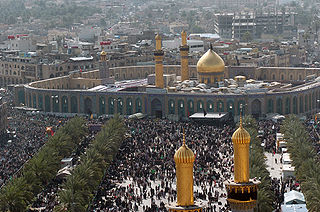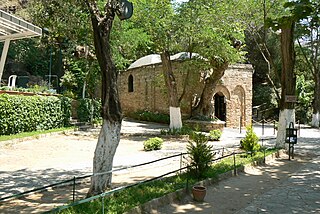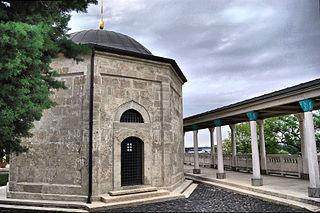 W
WSafa and Marwa are two small hills, connected to the larger Abu Qubais and Qaiqan mountains, respectively, in Mecca, Saudi Arabia, now made part of the Masjid al-Haram. Muslims travel back and forth between them seven times in what is known as Sa'ee ritual pilgrimages of Ḥajj and Umrah.
 W
WThe Arbaʽeen Pilgrimage, or the Arbaʽeen Walk, is the world's largest annual public gathering that is held every year in Karbala, Iraq at the end of the 40-day mourning period following Ashura, the religious ritual for the commemoration of martyrdom of the grandson of Prophet Mohammad and the third Shia Muslim Imam, Husayn ibn Ali's in 61 AH. Anticipating Arbaʽeen, or the fortieth day of the martyrdom, the pilgrims make their journey to Karbala on foot, where Husayn and his companions were martyred and beheaded by the army of Yazid I in the Battle of Karbala.
 W
WBayn al-Haramayn, also transliterated as Bainul Haramain, is the area between the Imam Husayn Shrine and al-Abbas Shrine, which is a distance of 378 meters. It is said to be the exact place where the fighting in the Battle of Karbala took place.
 W
WThe Black Stone is a rock set into the eastern corner of the Kaaba, the ancient building in the center of the Grand Mosque in Mecca, Saudi Arabia. It is revered by Muslims as an Islamic relic which, according to Muslim tradition, dates back to the time of Adam and Eve.
 W
WThe Cave of the Patriarchs or Tomb of the Patriarchs, known to Jews as the Cave of Machpelah and to Muslims as the Sanctuary of Abraham, is a series of caves located in the heart of the Old City of Hebron in the southern West Bank. According to the Abrahamic religions, the cave and adjoining field were purchased by Abraham as a burial plot.
 W
WThe Grand Magal of Touba is the annual religious pilgrimage of the Senegalese Mouride Brotherhood, one of the four tariqa of Senegal. On the 18th of Safar, the second month of the Islamic calendar, pilgrims gather in the holy Mouride city of Touba to celebrate the life and teachings of Cheikh Amadou Bamba, the founder of the brotherhood.
 W
WGül Baba, also known as Jafer, was an Ottoman Bektashi dervish poet and companion of Sultan Suleiman the Magnificent who took part in a number of campaigns in Europe from the reign of Mehmed II onwards.
 W
WThe Hajj is an annual Islamic pilgrimage to Mecca, Saudi Arabia, the holiest city for Muslims. Hajj is a mandatory religious duty for Muslims that must be carried out at least once in their lifetime by all adult Muslims who are physically and financially capable of undertaking the journey, and can support their family during their absence.
 W
WIslamic writers claim it started from the time of Abraham through the establishment of the Islamic Hajj by Islamic prophet Muhammad, to the present-day hajj where millions of Muslims perform their pilgrimage annually. In Islamic tradition, pilgrimage was introduced during the time of prophet Ibrahim (Abraham). Upon God's command, he built Kaaba which became the destination of pilgrimage. For the pagan Arabs in the Pre-Islamic Arabia, Kaaba was still the center of their worshiping. The present pattern of the Islamic Hajj was established by Muhammad, around 632 CE, who made reforms to the pre-Islamic pilgrimage of the pagan Arabs. During the medieval times, pilgrims would gather in chief cities like Basra, Damascus, and Cairo to go to Mecca in groups and caravans comprising tens of thousands of pilgrims.
 W
WIn addition to the three mosques accepted by all Muslims as holy sites, Shi'ite Muslims consider sites associated with Muhammad, his family members and descendants, to be holy. After Mecca and Medina, Najaf, Karbala and Jerusalem are the most revered by Shias.
 W
WAccording to Sahih al-Bukhari, Muhammad said "Do not prepare yourself for a journey except to three Mosques: Masjid al-Haram, the Mosque of Aqsa (Jerusalem) and my Mosque." In the Islamic tradition, the Kaaba is considered the holiest site, followed by the Al-Masjid an-Nabawi and Al-Aqsa Mosque.
 W
WThe House of the Virgin Mary is a Catholic shrine located on Mt. Koressos in the vicinity of Ephesus, 7 kilometres (4.3 mi) from Selçuk in Turkey.
 W
WAn Imāmzādeh refers to an immediate descendant of a Shi'i Imam in the Persian language. This Persian term is also used in Urdu and Azeri.
 W
WRauza Sharif or Shaikh Ahmad al-Faruqī al-Sirhindī Dargah is situated on the Sirhind-Bassi Pathana Road at a small distance to the north of Gurdwara Fatehgarh Sahib. Sheikh Ahmed Farooqi lived at this place during the times of Akbar and Jahangir from 1563 to 1624.
 W
WGül Baba's tomb (türbe) in Budapest, Hungary, is the northernmost Islamic pilgrimage site in the world. The mausoleum is located in the district of Rózsadomb on Mecset (mosque) Street, a short but steep walk from Margaret Bridge.
 W
WTurkistan, is a city and the administrative center of Turkistan Region of Kazakhstan, near the Syr Darya river. It is situated 160 km (100 mi) north-west of Shymkent on the Trans-Aral Railway between Kyzylorda to the north and Tashkent to the south. Its population has increased within ten years from 102,505 to 142,899 . Turkistan's most prominent historical and cultural asset is the Mausoleum of Khoja Ahmed Yasawi, a UNESCO World Heritage site. The city will be served by Hazrat Sultan International Airport.
 W
WThe ʿUmrah is an Islamic pilgrimage to Mecca that can be undertaken at any time of the year, in contrast to the Ḥajj, which has specific dates according to the Islamic lunar calendar.
 W
WThe Zamzam Well is a well located within the Masjid al-Haram in Mecca, Saudi Arabia, 20 m (66 ft) east of the Kaaba, the holiest place in Islam. According to Islam, it is a miraculously generated source of water from God, which sprang spontaneously thousands of years ago when Ibrahim's (Abraham's) son ʾIsmaʿil (Ishmael) was left with his mother Hajar (Hagar) in the desert, thirsty and crying. Millions of pilgrims visit the well each year while performing the Hajj or Umrah pilgrimages in order to drink its water.